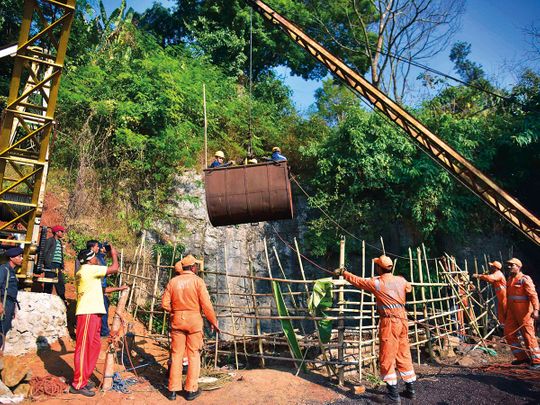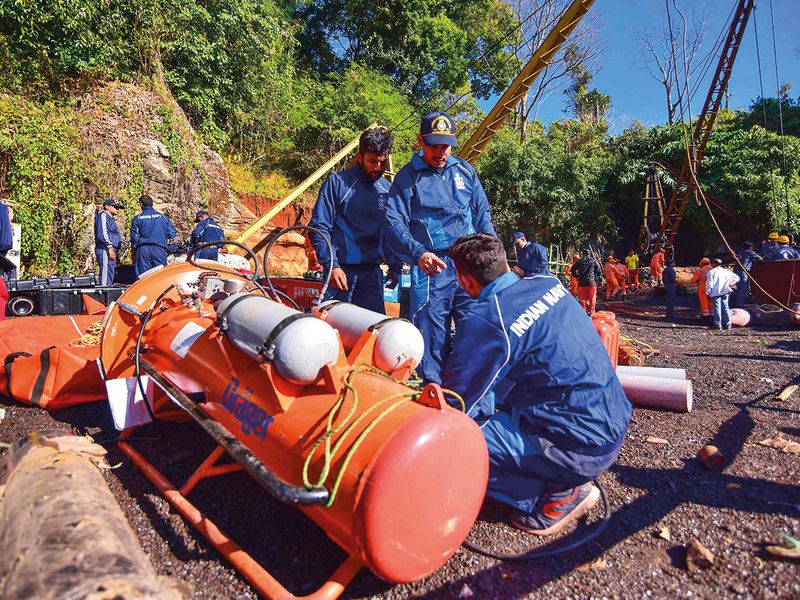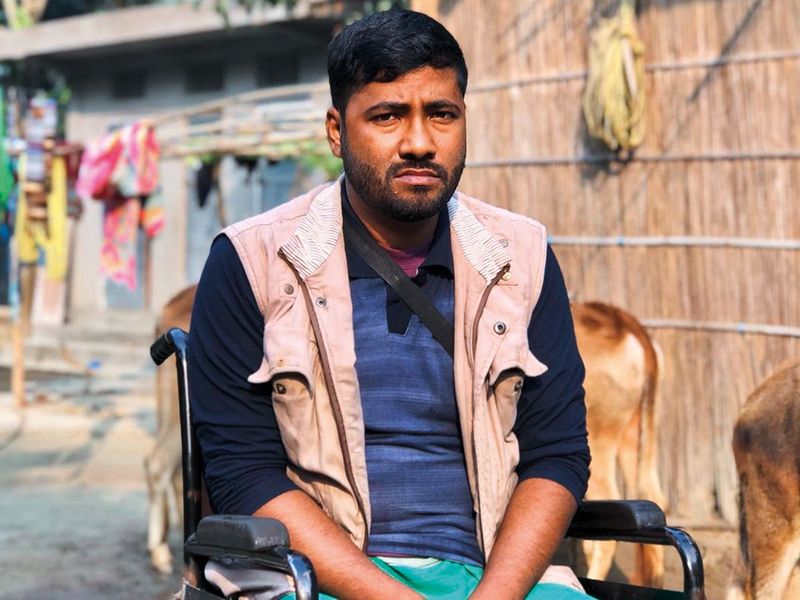
Abdul Alim spent less than a week working inside the 370-foot-deep coal mine before deciding he’d had enough. The pit was too dangerous, the risk of flooding too great, the safety equipment nonexistent.
When a boss brought him and other workers to a market one evening to buy supplies, Alim told him he wanted to look for a belt. He and another miner slipped into the crowd and fled, hitching a ride and travelling 12 hours back home to their villages in northeastern India.
Three days later came news of what Alim had feared: The mine had collapsed and filled with water, trapping 15 workers.

The others were as scared as me, but they didn’t dare to leave...
More than a month after the December 13 collapse, a rescue effort led by Indian navy divers and federal emergency management experts located one body floating deep inside the mine shaft — although it was too badly decomposed to be retrieved — but found no sign of any others. Anguished family members presume all 15 men are dead.

The disaster in Meghalaya — a rugged state rich in minerals, whose benefits have eluded the vast majority of its people — has prompted a new reckoning over “rat hole” mines, named for the suffocatingly narrow tunnels that miners plow into the hillsides to extract coal.
The risky method has been used in Meghalaya for decades, even after an Indian environmental court in 2014 ordered a halt to all coal extraction in the state after the deaths of 15 men in another rat hole mine.
Though it is illegal, mining in Meghalaya has continued under the sanction of influential politicians — many of whom are mine owners — and because of a nearly endless supply of labourers willing to brave the dark channels to dig out a material that remains India’s most important energy source.
“I thought something like this would happen,” Alim, 28, said in the dirt courtyard of a neighbour’s house in Magurmari, a grey farming village along a river in western Meghalaya, where chickens and barefoot toddlers roam the sole dirt road.

Nowhere has been hit as hard by the collapse as this hamlet of fewer than 1,500 people: Of the 15 missing miners, five hail from Magurmari. They had been recruited by a sardar, or manager, who promised “handsome salaries” for working in the rat holes.
Alim had expected about $700 for a month’s work at the mine at Ksan in the Jaintia Hills, 40 miles southeast of the state capital, Shillong.
“The others were as scared as me,” Alim said, “but they didn’t dare to leave because of pressure from the manager, and because they needed the money.”
The lion’s share of the state’s mining wealth accrues to a small, politically connected elite — what India’s National Green Tribunal in its 2014 ruling referred to as “coal mafias.”
The Meghalaya government has said it stood to lose nearly $100 million in annual revenue because of the ban, and even after the latest mine collapse has argued for the moratorium to be lifted. In January, the state’s top official, Chief Minister Conrad Sangma, said that while the “environment and safety of miners must be given priority,” he didn’t see a mining ban “as a solution right now.”
Even as India embarks on some of the largest solar energy projects in the world, coal still supplies 57 per cent of the energy needs of its fast growing economy.
The fossil fuel found in northeastern India accounts for only about 1 per cent of the country’s total coal production, and is too sulfurous and generates too much carbon to be burned in power plants. It is mainly used to power paper mills, cement factories and other small enterprises across a region that lacks major industries and has long been economically and politically distant from New Delhi.
“Coal is one of the only major business opportunities in Meghalaya,” said Om Prakash Singh, an environmental studies professor at North-Eastern Hill University in Shillong. “It’s not going to make any difference in the economy of the country, but it is very lucrative for some local people.”
Along the rutted, two-lane highways surrounding Meghalaya’s mining regions, giant mounds of freshly dug coal are piled up in windswept fields and at weigh stations. In November, when Singh joined a panel of court-appointed experts to survey the state’s compliance with the mining ban, officials insisted against all logic that the coal visible from the roads had been mined before 2014, and was therefore legal to transport and sell.
Last month, India’s Supreme Court ordered a one-month freeze on transporting coal in the state.
Unlike in other parts of India, where coal is extracted from large, open-cast mines that denude entire landscapes, the coal in Meghalaya lies in thin bands running beneath low, rocky hills. Miners must descend vertical shafts hundreds of feet deep with the aid of bamboo ladders or cranes, then use pickaxes to burrow horizontally into the earth to reach coal seams that often measure only a few feet across.
They crawl into the rat holes — barely wider than the distance between a man’s shoulders — in teams of two, the second miner loading the coal onto a small wooden cart. Cranes usually hoist the dark lumps to the surface in conical baskets; other times, the miners carry the coal out on their backs.
To negotiate the tight passageways, local bosses recruited migrants and underage labour from as far away as Nepal. At the start of this decade, one advocacy group estimated that 70,000 children were working in the mines.
That practice has all but ended, activists said, but miners in Meghalaya still use little science and even less safety equipment. Alim, who has worked in several mines, said he had never been trained nor given so much as a flashlight to navigate the dank, slippery tunnels filled with stale, toxic air.
“When accidents happen, the mine owners don’t bother much,” Singh said. “They can find labourers from anywhere.”

Abdul Karim Sheik said he was 17 when he started working in the mines a decade ago alongside his older brother. At age 21, he was picking his way through a rat hole when a chunk of rock loosened from above and crushed his spinal cord, leaving him paralysed and confined to a wheelchair.
In November, a recruiter arrived in the village and offered his brother, 32-year-old Abdul Kalam Sheik, a job at the mine in Ksan. His wife was pregnant with their second child, and with their father weakening due to age, there was no one else in the family to earn a living.
Abdul Karim Sheik said he urged him not to go, “but he insisted, saying he could support us.”
The older brother and Alim were among about 20 miners who arrived at Ksan in early December. Alim recalled his alarm when he noticed that abandoned mines nearby had filled with water — an indication that earlier rat holes had collapsed.

It was not just an attack against me, but a signal to others.
Activists say that due to unchecked mining and runoff, sulfur from the coal has seeped into rivers and streams. Last year, a report by Agnes Kharshiing, head of the Shillong-based Civil Society Women’s Organisation, found high levels of water pollution and deforestation in the Jaintia Hills, home to most of the state’s coal.
In November, Kharshiing and her colleague Anita Sangma — who is no relation to the chief minister — were photographing illegal mining in the hills when they came under attack from about two dozen mine owners and bosses. The mob struck Kharshiing with stones and sticks, leaving her unconscious and bleeding heavily from the scalp.
“We’re going to finish her,” Sangma recalled some of the assailants saying. The women recognised one of the men as Nidamon Chullet, a leader of the National People’s Party, which governs the state in alliance with Prime Minister Narendra Modi’s Bharatiya Janata Party.
Kharshiing would spend a month in the hospital before being released. The attack was particularly shocking in Meghalaya, a predominantly matrilineal society that teaches respect for women.
“It was not just an attack against me, but a signal to others,” she said as she lay in bed recovering, her torso wrapped in a brace.
She has not remained silent: Last month, she and fellow activists released another report that named several prominent politicians who allegedly owned or were otherwise connected to illegal mines, including four ministers in Sangma’s government.
Police arrested six people in the attack against her, including the mine owner. On Christmas Day, Chullet surrendered to authorities.
The National Green Tribunal last month ordered the state to pay a $14-million fine for failing to curb illegal mining. State officials said they would challenge the ruling — even as two men died in a separate mine tragedy in the first week of January.
The families of the men missing at Ksan blame state officials for what happened. After the collapse December 13, it took nearly two weeks for high-powered pumps to arrive to speed up the removal of water from the chasm. According to Indian news reports, the delay was partly due to officials going on vacation over Christmas in the majority Christian state.
The state has promised each miner’s family interim compensation of about $1,420, but no money has arrived in Magurmari.
Clutching a photo of Abdul Kalam Sheik, his father, Bodiot Jamal, said he hoped his son’s body would be brought home so he could be buried in the Muslim tradition.
“For a few days we hoped he had survived,” he said. “But now we don’t have any faith.”
–Los Angeles Times












